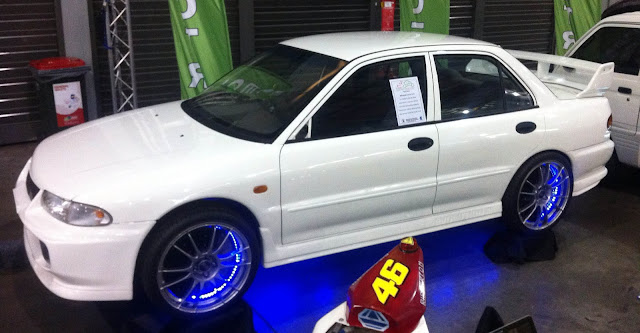Australia based start-up company Evans Electric have unveiled an All Wheel Drive In-Wheel Motor powered Lancer Evo 3 during Meguiar's MotorEx at Sydney Olympic Park
The 4 door sedan with World Rally Championship pedigree features a direct drive, disc type electric motor in each of it's 19” wheels. Each Axial Flux 3 phase AC Induction wheel motor has a nominal output of 75 kw and 625 Nm of torque with a peak output of 150 kw and 1,250 Nm giving the vehicle a total peak output of 600 kw (800 hp) and 5,000 Nm.
While the torque figure could at first glance appear fantastic, standard automotive industry practice only quotes torque at the flywheel not at the wheels. As an example the Tesla Model S Performance has a quoted peak motor torque of 600 Nm. With a single speed reduction gear ratio of 9.73:1 that equates to a total of 5,838 Nm (minus gearing losses) at the wheels. The Evans Electric motors are direct drive, so the rotor turns at the same speed as the wheel. Instead of mechanical reduction gearing, they are electrically geared using an 8 pole stator winding configuration.
Direct drive wheel motors eliminate mechanical transmission losses allowing up to 85% of a vehicle's kinetic energy to be recoverable during braking. Maximising brake regeneration lowers a vehicles over-all energy consumption potentially leading to more range per kWh of battery capacity or the use of a smaller battery pack for similar range. As the battery is the single most expensive component in an EV this could lead to lower cost electric cars.
The Evans Electric in-wheel motors enable non-contact electromagnetic braking, replacing hydraulic friction brake systems which are 99% redundant in current generation electric/hybrid vehicles. Using only the wheel motors, the car can brake at greater than 1G.
Evans Electric hold a patent for a vehicle drive system using wheel motors for propulsion and braking, the most impressive feature of which is that safety and vehicle dynamics features such as ABS, stability control, traction control, brake steer, active brake bias, torque vectoring, intelligent cruise control, emergency brake assist and collision avoidance all become customisable and upgradable software functions.
When these systems are combined with wheel motors they allow a new level of performance based active yaw control that unlike most current stability control systems (which only activate in an emergency situation) are active at all times, dynamically fine tuning understeer and oversteer to enhance cornering speed and safety.
After an extensive period of wheel motor validation testing and power electronics development the company has met with several automotive Tier 1 suppliers to discuss collaboration &/or licensing to move the project from proof of concept to commercial product development.
Final preparations are under way with track testing expected to commence by the time the Bathurst 1000 rolls around in October.

